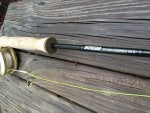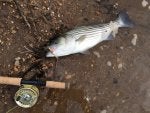Happy Canadian Thanksgiving. A question about single hand rods. What can I expect if I go from a 9 foot 7 weight to a 10 foot 7 weight? Thanks for any comments.

138 posts
·
Joined 2024
The 10’ers I have have heavier swing weights (they don’t feel as ‘light’ when casting if that makes sense) and feel closer to the next rod weight up than their 9’ counterparts. You gain an advantage nymphing and mending, casting when wading in deeper water (fishing a lake maybe) and most applicable to this forum, I think they handle single hand Spey fishing better than 9’ers. I really enjoy fishing my 10’ 8wt with a rio single hand Spey line for smaller Atlantic salmon rivers!
80 posts
·
Joined 2023
HAPPY THANKSGIVING oh Canada! But I’m rooting for the Seattle Mariners (and Seahawks).
So what to expect going from a 9’ single hand fly rod to a 10’ 7wt? As backstory to my POV … when I was teaching myself how to fly fish 30 some years ago I read “Striper Moon”. That book was much about using Salmon fishing techniques for Striped Bass fishing (Anadromous fish). It was also about the utility of using a longer rod (10 foot plus).
In short (unintentional pun) it makes way too much sense to use a longer rod when wade fishing. For starters your back cast is more likely to stay off the water (fouling) … and line control (mending, swinging drifts) is “easier” because the leverage (length of the lever) is greater.
But for comfort in casting you might want use a heavier in weight fly reel for counter balancing the longer and slightly heavier fly rod (like an Islander reel instead of a Danielsson). And in casting fly line you might want to line “up” from a WF 7wt to an WF 8wt … because you have more fly rod to load. A major caveat being, one always has to dial in fly line type & grain weight to a specific fly rod.
In my fly fishing experience at my local river I’ve used (throughly enjoyed) 10ft 7&6wt fly rods 75% of the time in over 3 decades of fishing. Currently (as my Avatar shows) I’m using an 11ft 3wt Trout Spey rod in a single hand fashion. It‘s equivalent to a 10’ 6” 6/7 wt standard single hand fly rod. When I’m not using that Switch rod I’ll have a 10’ 6wt Sage XP fly rod in my single hand.
I hope this helps in your fishing quests.
![Image]()
![Image]()
So what to expect going from a 9’ single hand fly rod to a 10’ 7wt? As backstory to my POV … when I was teaching myself how to fly fish 30 some years ago I read “Striper Moon”. That book was much about using Salmon fishing techniques for Striped Bass fishing (Anadromous fish). It was also about the utility of using a longer rod (10 foot plus).
In short (unintentional pun) it makes way too much sense to use a longer rod when wade fishing. For starters your back cast is more likely to stay off the water (fouling) … and line control (mending, swinging drifts) is “easier” because the leverage (length of the lever) is greater.
But for comfort in casting you might want use a heavier in weight fly reel for counter balancing the longer and slightly heavier fly rod (like an Islander reel instead of a Danielsson). And in casting fly line you might want to line “up” from a WF 7wt to an WF 8wt … because you have more fly rod to load. A major caveat being, one always has to dial in fly line type & grain weight to a specific fly rod.
In my fly fishing experience at my local river I’ve used (throughly enjoyed) 10ft 7&6wt fly rods 75% of the time in over 3 decades of fishing. Currently (as my Avatar shows) I’m using an 11ft 3wt Trout Spey rod in a single hand fashion. It‘s equivalent to a 10’ 6” 6/7 wt standard single hand fly rod. When I’m not using that Switch rod I’ll have a 10’ 6wt Sage XP fly rod in my single hand.
I hope this helps in your fishing quests.
Attachments
-
1.3 MB Views: 3
-
1.6 MB Views: 3
250 posts
·
Joined 2021
I can only go by my experience. I used a couple of different 10’ 7 wts for quite a few years. They were great for distance on bigger rivers and were quite capable of safely fighting and landing Atlantic salmon well over 20 lbs. What I did find on the negative side is that the 10 footers were more sensitive to wind than 9 foot rods ( certainly a factor here in Newfoundland) and that they required greater effort to cast. This came to a head this year (at age 72) after I had a fall last winter and suffered a separated right shoulder. It healed eventually and I was able to do my usual salmon fishing trips without a problem….except that my current 10 foot 7 wt (a Loop 7X) was just too much rod. I found it painful and tiring to use for more than a very few minutes while I had no problem at all using 9 and 9 1/2 foot 7 and 8 wt. rods. So, for regular wet and dry fly fishing for Atlantic salmon, what have I lost? Probably 7 to 10 feet in casting range, basically nothing for all practical purposes. Far be it from me, a confirmed tackle tart, to discourage anyone from buying more gear but do because you want to, not because there’s any real need.
521 posts
·
Joined 2022
Personally, I prefer a 10' 7wt for single hand Spey casting and a 9' 7wt for conventional overhead casting. The 10' gives a bit more distance and bit more drift control. It is easy on the arm and shoulder when Spey casting and is preferred when using sink tips or heavy flies as it helps to get the line to the surface easier. The 9' is a bit easier on the arm and shoulder for overhead casting and is a bit more accurate for fly placement when overhead casting. My 10' 7wt is two-piece and my 9' is 4-piece so if I am traveling I usually stick with the 9' rod. If you can't decide then a compromise is the 9'6" 7wt which was a common size used for steelhead in years gone by. I believe the legendary steelhead fisherman Lani Waller used a 9'6" 7wt in his films on Steelhead fishing.
1,324 posts
·
Joined 2003
crashing into more things when bushwhacking to fishing spot.What can I expect if I go from a 9 foot 7 weight to a 10 foot 7 weight? Thanks for any comments.
better chances of breaking/stepping on rod tip when stowed in boat.
good excuse for buying a bigger fishing vehicle.
510 posts
·
Joined 2010
I am saying this specifically for salmon and steelhead fishing. The right 10' 7wt is dignificantly better than a 9' rod in the following aspects:
- Mending and line management
- managing the swing/drift through complex current/water column
- May add a bit better sock absorption on a violent take
- Better at fighting fish with lighter leader/tippet combo
- A better nymphing rod
- may give you a bit more stealth in low water conditions (you can stay farther back from the drift, use/manage a longer leader)
- May not be as accurate as a 9' rod
-
?
-
?
-
?
-
?
-
?
-
?
-
?
-
?
-
?
-
?
-
?
-
?
-
?
-
?
-
?
-
?
-
?
-
?
-
?
-
?
- posts
- 938K
- members
- 26K
- Since
- 2000
A forum community dedicated to Spey casting, fishing, flies, and enthusiasts. Come join the discussion about trails, licenses, fishing, game laws, styles, reviews, optics, accessories, classifieds, and more!
Explore Our Forums
Top Contributors this Month
View All
Yooper-Fly
122 Replies
drylinetim
58 Replies
PositiveCreep
41 Replies





